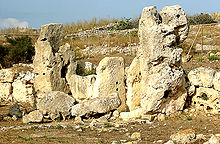
Back Skorba Catalan Skorba Corsican Tempel von Skorba German Skorba Spanish سکوربا Persian Skorba French Սկորբա Armenian Scorba Italian Skorba Lithuanian Skorba Maltese
 | |
| Location | Żebbiegħ, Mġarr, Malta |
|---|---|
| Coordinates | 35°55′14.84″N 14°22′39.58″E / 35.9207889°N 14.3776611°E |
| Type | Temple Village |
| History | |
| Material | Limestone |
| Founded | c.4850 BC (earliest remains) c.3600 BC (temple) |
| Periods | Għar Dalam phase Grey Skorba phase Red Skorba phase Ġgantija phase Tarxien phase |
| Site notes | |
| Excavation dates | 1914–1961 |
| Archaeologists | David Trump |
| Condition | Ruins |
| Ownership | Government of Malta |
| Management | Heritage Malta |
| Public access | Yes |
| Website | Heritage Malta |
| Part of | Megalithic Temples of Malta |
| Criteria | Cultural: (iv) |
| Reference | 132ter-005 |
| Inscription | 1980 (4th Session) |
| Extensions | 1992, 2015 |
| Area | 0.103 ha (11,100 sq ft) |
The Skorba temples are megalithic remains on the northern edge of Żebbiegħ, in the Northern Region of Malta, which have provided detailed and informative insight into the earliest periods of Malta's neolithic culture.[1] The site was only excavated in the early 1960s, rather late in comparison to other megalithic sites, some of which had been studied since the early 19th century. The site's importance has led to its listing as a UNESCO World Heritage Site, a listing it shares with six other megalithic temples in Malta.
This later excavation allowed the use of modern methods of dating and analysis. The temple itself is not in good condition, especially in comparison to the more complete temples of Ħaġar Qim and Tarxien. However, the importance of this site does not lie in the actual remains but rather in what was garnered from their excavation.[2]
